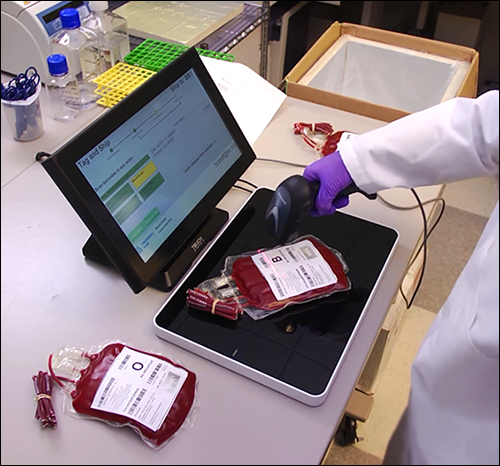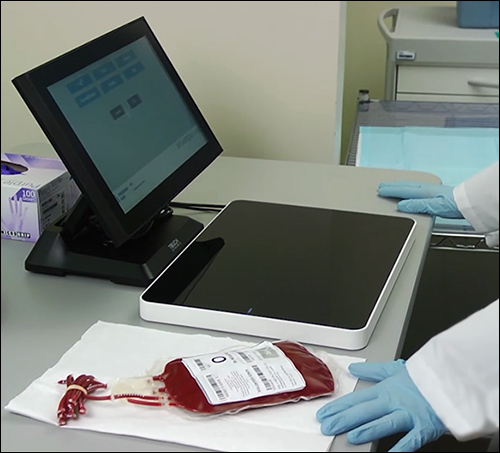Children’s Hospital of Wisconsin and BloodCenter of Wisconsin are piloting a high-frequency (HF) RFID system’s use in monitoring a challenging product: blood stored and provided for pediatric patients. Because children require less blood than adults, the products are often split into smaller packages for transfusion recipients who could be as young as a newborn infant. The pilot, which started on Oct. 31, 2016, ended this week, on Feb. 15. The RFID solution is known as CompoTrace and is provided by health-care technologies company Fresenius Kabi.
BloodCenter of Wisconsin—a nonprofit organization that specializes in blood services; organ, tissue and marrow donation; diagnostic testing; and medical services and research—is part of health-care organization Versiti. The blood center teamed up with Fresenius Kabi to begin piloting the passive HF RFID-based solution. The facility has been researching and testing RFID technology for more than a decade, to better manage its blood supply as the product passes from the center to hospitals for use by patients (see BloodCenter of Wisconsin to Study RFID’s Effect on Blood and Consortium Pilot Finds RFID Improves Efficiency of Blood Supply Chain).
The latest project was designed to determine how the technology could benefit the visibility and management of blood supplies for the smallest of patients. “Children’s transfusions differ from adults’ because the doses are much smaller,” says Lynne Briggs, BloodCenter of Wisconsin’s VP and CIO. A blood bag stores a specific dosage for adults, she explains, but an infant or small child would use only a small percentage of that dose. Rather than blood being wasted that isn’t required for a young patient, the product is split into multiple pediatric doses.
Monitoring products that are split and stored in multiple bags can be more complicated than tracking a single dose that is administered to a patient in the same bag in which it was initially collected and stored. As a result, Briggs says, the blood center and Fresenius-Kabi wanted to determine how well the technology could help track the original adult-sized dose, as well as subsequent smaller pediatric doses. “This allows us to be better stewards of the blood supply,” she explains.
The pilot consists of tracking blood products at two locations: BloodCenter of Wisconsin distribution site where the blood is shipped by its BloodCenter Hospital Services team, and the Children’s Hospital of Wisconsin, where it is handled by the Hospital Transfusion Services team, using the CompoTrace system.
BloodCenter and Children’s Hospital pilot is the first pediatric deployment of the CompoTrace solution, says Dale H. Meixelsperger, Fresenius Kabi’s marketing senior manager.
The pilot’s goals include confirming that the technology works, identifying when inventory storage could be “right-sized” by reducing or increasing the amount of blood being stored, and otherwise improving inventory management. It is also intended to optimize hospital deliveries and collect data to align blood demand with blood recruitment efforts, according to Roberto Vilardi, Fresenius Kabi’s director of data management.
If a blood bag is split into several containers, either at the blood center’s distribution site or at the hospital, RFID tags can be applied to the new pediatric bags. Each new tag ID number can then be linked to the original product bag. With the Fresenius Kabi technology, Children’s Hospital can view blood components that are in its Transfusion Services inventory whether they are in storage or have been removed for transfusion.
First, BloodCenter personnel at the distribution site receive an order for blood products, which they prepare for shipment to the hospital, located seven miles away. At the time of shipping, workers apply 13.56 MHz HF RFID tags, compliant with the ISO 15693 standard, to the blood component. The RFID tag’s unique ID number is linked to each product code, type, expiration data and donation ID in the CompoTrace system. If the products are requested in pediatric sizes, they are split at the center.
At the hospital, Fresenius Kabi has installed its RFID kiosk with a touchscreen PC and a connected Feig Electronic reader, as well as a bar-code scanner. Transfusion Services staff members select the “Receive” prompt on the kiosk touchscreen to update its status as received at the hospital, then place the bag on an RFID reader to link that product to the action.
When a physician requests product from the hospital’s storage area, a Transfusion Services technician pulls product from storage and brings it back to the kiosk. At the touch screen, the technician selects “Dispense” and places the blood component on the RFID reader in order to indicate that the item has been pulled from inventory for a potential transfusion. That status is then updated in the software, which resides on a cloud-based server.
If the physician does not use the blood component, the unit is returned to Transfusion Services. A technician places the unused unit on the reader in order to “Restock” the item back into inventory.
“The system is designed to augment existing hospital Transfusion Services information systems,” Meixelsperger says, “and to work in conjunction with the bar-code identification and labeling processes currently in place.” With that in mind, he notes, CompoTrace is a standalone system with no current interfaces, which makes it simple for employees to use. “That is why we designed CompoTrace with few steps to change the status of the product—for example, dispensed or received.”
The CompoTrace system does not access or store patient information, Meixelsperger says, thereby ensuring the privacy of the patient. BloodCenter of Wisconsin and Fresenius Kabi are currently evaluating the pilot’s results, after which they plan to determine the next step.
The technology, Briggs says, may help the blood center and the hospital to better understand their inventory and prevent overstocking that could lead to expiration. “I think there are things we thought we knew,” she states, “but we are still finding information in the data that can help us better manage inventory together.” Even reducing the inventory stock by 10 to 15 percent, Briggs notes, would lower costs and ensure that blood products are used while still fresh.
Briggs adds that she would like to see the technology tested at a hospital with a busy trauma center, to determine how the system improves visibility, efficiency and blood management as the bags are moved in high volume. “Blood product is a precious gift someone has given us,” Briggs says, adding that BloodCenter of Wisconsin wants to do all it can “so that those gifts can be used to their best advantage, and waste is avoided.”
Images provided courtesy of Fresenius Kabi.




